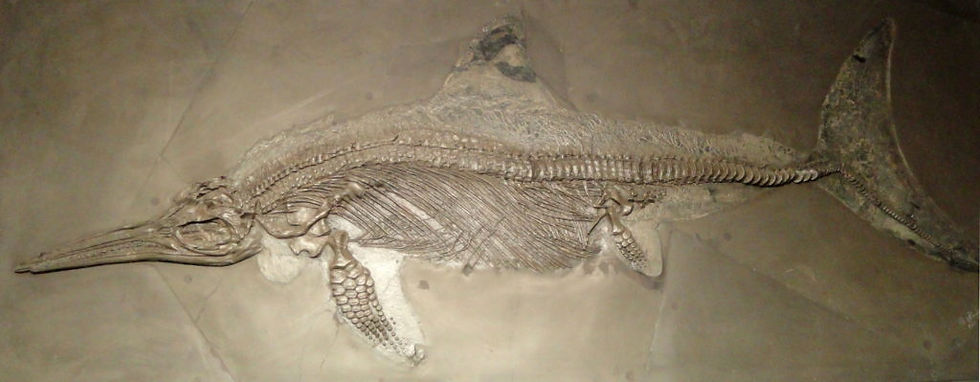250 million years ago... when the climate was hot and dry, and deserts blanketed the majority of the land... after an enormous mass extinction had wiped out 96% of all marine species (known as the "Permian-Triassic extinction event")... when dinosaurs were only just beginning to evolve... enormous predatory creatures lurked in the depths of the oceans. Ancient sharks were very successful in these prehistoric oceans, but they were not alone... they shared their waters with another predatory colossus: Ichthyosaurs. So how did ichthyosaurs and sharks live side by side? Did they interact? And how do we know?

A Long, Long Time Ago...
Today's Hexanchidae family of sharks (aka the six-gills) are direct descendants of sharks from the Mesozoic period (252 to 66 million years ago). The oldest known fossil record of one of these ancient ancestors (a group known as Notidanodons) was found in New Zealand, in rock dating from somewhere around 149 million years ago (Cappetta & Grant-Mackie, 2018).
When we talk about the Notidanodon, we are actually referring to a genus of at least six species. Fossil specimens which have been used to describe these creatures have been found in Denmark and Sweden, Russia, the UK, Argentina and the USA, India, Japan and Antarctica (Cappetta & Grant-Mackie, 2018; Serafin et al, 2020).
Based upon what we know about how landmasses have moved over the last few hundred million years, it is thought that Notidanodon sharks could be found throughout the ancient Pacific Ocean, all the way from Siberia to Gondwana, if not all around the globe (Cappetta & Grant-Mackie, 2018; Serafin et al, 2020).
Around the same time, a marine reptile known as an ichthyosaur was also a top predator throughout these ancient oceans (Serafin et al, 2020).

Same Same, but Different
We know of at least 100 species of ichthyosaurs, which lived between 250 - 90 million years ago. At a glance, you might think these animals are related to sharks or whales, but, in fact, they evolved from terrestrial reptiles which returned back to the sea. Similarly to how whales and dolphins evolved from terrestrial mammals which returned back to the oceans (Serafin et al, 2020).

Ichthyosaur = '
ichthyo' - fish (19th Century English)
& 'sauros' - lizard (Greek)
Therefore, ichthyosaurs had many reptilian features: they breathed air and the shape of their skeleton shows us that they changed from having four limbs (aka "tetrapods"), to having a flattened tail for swimming. Yet, they also had a very similar body form to fish; streamlined, with paddle-shaped forelimbs for swimming (Serafin et al, 2020).
When two animals from different evolutionary lines are adapted to have similar forms we call this "convergent evolution" (Serafin et al, 2020).
Sharing Space
Based upon carbon dating of rocks where Notidanodon teeth and ichthyosaur skeletons have been found, scientists have assumed that these creatures must have come into contact with each other at some point... but now we have physical evidence! In a remarkable find, scientists have learned that, not only did these two ocean giants coexist, but they ate each other (Serafin et al, 2020).
An incredible fossil found in northern Italy clearly shows a tooth from a Notidanodon shark preserved alongside the rib of an ichthyosaur. The scientists studying the specimen have hypothesised that the tooth of the shark probably became imbedded in the rib when a Notidanodon was scavenging on a dead ichthyosaur. This is a very exciting find because it tells us that Notidanodon sharks used ichthyosaurs as a food source (Serafin et al, 2020).

Game Changer
This fossil also tells us Notidanodon sharks were around much earlier than we previously thought! The age of the rock that this tooth was found in predates any other Notidanodon specimen ever discovered and tells us that these creatures were roaming the oceans at least 150 million years ago! (Serafin et al, 2020)

Other fossil records form this region show us that these oceans contained ammonites, nautiloids, unusual star fish and corals, and ancient shellfish. So it is very possible that Notidanodon sharks targeted any or all of these animals for food. But on this occasion we have been lucky enough to capture a snap-shot in prehistory, when a plucky shark made the most of an easy meal when it discovered a dead ichthyosaur... Even back then, who could turn down an all you eat buffet? (Serafin et al, 2020).
If you would like to learn more about Ichthyosaurs, I would thoroughly recommend you check out David Attenborough's wonderful documentary 'Attenborough and the Sea Dragon', which is available through the BBC or DailyMotion. Attenborough is (unsurprisingly) dazzling in this show.
References
Cappetta H & Grant-Mackie J (2018). Discovery of the most ancient Notidanodon tooth (Neoselachii: Hexanchiformes) in the Late Jurassic of New Zealand. New considerations on the systematics and range of the genus. Palaeovertebrata, 42:1, e1. Access online.
Serafin A, Amalfitano J, Cobianchi M, Fornaciari B, Maxwell EE, Papazzoni CA, Roghi G & Guisberti L (2020). Evidence of opportunistic feeding between ichthyosaurs and the oldest occurrence of the hexanchis shark Notidanodon from the upper Jurassic of Northern Italy. Rivista Italiana di Paleontologia e Stratigrafia (Research in Paleontology and Stratigraphy), 126:3, 629-655. Access online.
By Sophie A. Maycock for SharkSpeak






コメント